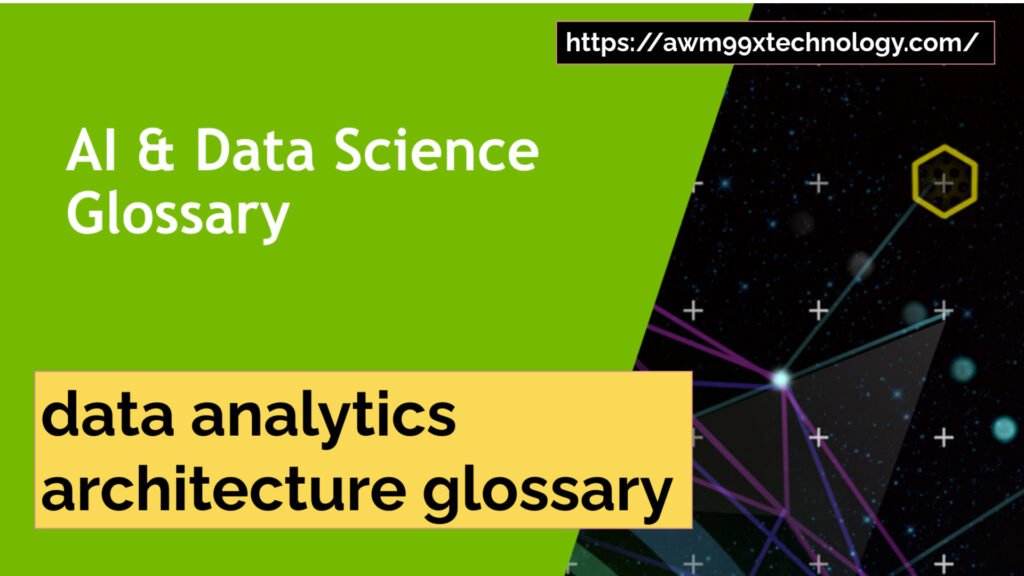Table of contents
- Introduction
- Key Points of data analytics architecture glossary
- Main Content
- What is data analytics architecture glossary?
- Data Warehouse in the Data Analytics Architecture Glossary
- ETL (Extract, Transform, Load)
- Data Lake in the Data Analytics Architecture Glossary
- Business Intelligence (BI)
- Data Modeling
- Data Governance: Insights from the Data Analytics Architecture Glossary
- Data Visualization
- Predictive Analytics
- Big Data
- Machine Learning
- Data Pipeline
- Data Quality
- Metadata
- Cloud Computing in data analytics architecture glossary
- Real-Time Analytics in the Data Analytics Architecture Glossary
- FAQs
- What is the difference between a data warehouse and a data lake?
- Why is data quality important in analytics?
- How does machine learning enhance data analytics?
- Conclusion
Introduction
In the field of data analytics, a glossary is an important tool as it is the most basic requirement for every practitioner as well as a fan. Words and phrases that are essential, such as those in the data analytics architecture glossary, are absolutely necessary in today’s corporate intelligence. With the emergence of big data and sophisticated analytics, it is always beneficial to have a good understanding of certain keywords, as it would help in managing operations effectively.

Key Points of data analytics architecture glossary
Important words used in construction of data analytics architecture are extensively discussed.
The examples provide context on the application of some words in practice.
Moreover, we provide educational materials and instruments related to the data analytics architecture glossary.
Main Content
What is data analytics architecture glossary?
Data analytic architecture can be seen as the framework that encompasses the entire data activity lifecycle such as data acquisition, management, analysis and presentation. That is essentially a strategy on how data is generated, stored, processed, retrieved, and consumed.
Definition: The architecture encompasses various components, including databases, data warehouses, ETL processes, and visualization tools. Additionally, each of these elements is essential to the overall data analytics architecture glossary.
Importance: A well-structured data architecture facilitates efficient data-driven decision-making processes and allows organizations to leverage insights effectively.
Data Warehouse in the Data Analytics Architecture Glossary
Data Warehouse can be defined as a dedicated storage site whose main purpose is to support and facilitate the tasks of reporting and the underlying analysis. It preserves more than one source importing structured data ready for querying.
Characteristics:
Organized files of data.
Managing historical data is crucial; additionally, it is key in the data analytics architecture glossary for analyzing trends and making informed decisions.
Furthermore, multidimensional querying facilitates efficient analysis and enhances the overall data processing capabilities.
Differences from Data Lakes: In contrast to data lakes which contain raw data, data warehouses deal with data that is organized and has a set structure.
ETL (Extract, Transform, Load)
ETL is a data integration method where data is sourced from several locations, transformed to fit a particular model and loaded into a system.
Steps involved in ETL:
Extract: Extract data from sources such as databases, files, and APIs.
Transform: Perform data cleansing and data formatting which involves the transformation of the data..
Load: Place the data in the data warehouse or data lake that has been prepared for loading.
Common Tools: Some ETL tools include Apache NiFi, Talend, and Informatica, these tools are highlighted in the data analytics architecture glossary for their unique features that enhance data processing and integration.

Data Lake in the Data Analytics Architecture Glossary
A data lake stores a large amount of unprocessed data in its original form until analysts need it for analysis; this concept is essential in the data analytics architecture glossary.
Definition: It enables the storing of data that is both structured and unstructured and a wide variety of data types
Use Cases in Big Data: Perfect fit for cases of big data, data lakes can store data from social media as well as IoT, among other devices and applications.
Business Intelligence (BI)
Strategies, capabilities, and technologies used for data analysis and reporting. It assists in making the most effective decision based on factual information among many organizations.
Key Features:
The majority of the business intelligence tools available today are essentially dashboards; moreover, these dashboards are a key component of the data analytics architecture glossary, providing critical insights for data-driven decision-making.
Data presentation techniques.
Data warehousing & data lakes integration.
How BI Leverages Data Architecture: Bi tools make use of structured data stored in data warehouses and other lakes to bring about transformational change.
Data Modeling
Data modeling defines the phenomenon of visualization of the structure of data and its relation with other data in the database or the data warehouse.
Types of Data Models:
Conceptual:Defines the overall structure of the data in the system but does not show the details.
Logical: Elaborates on the structure and shows how the various components relate with one another.
Physical: The physical implementation of the logical structure in the database management system.
Importance: The purpose of data structures is to enhance system designs; additionally, they are essential in the data analytics architecture glossary as they help protect the state of relevant entities.
Data Governance: Insights from the Data Analytics Architecture Glossary
Data Governance is ensuring that data is stored and remains usable, has integrity, and is protected from unauthorized access or mismanagement. This enables for efficient management of information through setting up policies or standards.
Key Principles:
The stewardship of data as a resource.
Compliance with such mandates.
Assurances on the members and the systems used.
Role in Data Quality and Compliance: Governance is all about strategies designed to ensure that all stored data is of high quality; moreover, it must meet security requirements as well.

Data Visualization
Data visualization is the process of taking numerical data which is important in making decisions and representing it in graphical format in charts. It papers the more complex data to a simpler form.
Importance: This has the effect of making it easier to understand insights from and cut across the important message contained in the data when making decisions.
Common Tools: Data visualization tools that are frequently used are Tableau, Power BI, and Google Data Studio.
Best Practices: Effective visualization practices include employing comprehensive diagrams; furthermore, they involve adhering to minimalism and maintaining fidelity to the data for clearer communication.
Predictive Analytics
Predictive analytics utilizes statistical algorithms and machine learning techniques to identify the likelihood of future outcomes based on historical data.
Techniques Used:Regression analysis, decision trees, and neural networks are considered common approaches.
Examples: Tasks include sales forecasting and forecasting target customer characteristics.
Big Data
Big data refers to datasets that are so large or complex that traditional data processing applications cannot deal with them effectively.
Characteristics:
Volume: This refers to the enormous amounts of data created on a daily basis.
Variety: These are different kinds of data and sourced from different places.
Velocity: This refers to the rate at which the data is created and the speed at which it is processed.
Challenges: They include storage, processing, and data security risks, among others; additionally, organizations must consider compliance and user access risks.
Artificial Intelligence in data analytics architecture glossary
AI enhances data analytics by automating data processing and providing advanced insights through algorithms.
Enhancements: AI increases the speed of analysis of the data and assists in revealing patterns that would be difficult to determine using ordinary methods.
Examples: Some of the applications include customer segmentation; moreover, they also encompass aberration detection, among other uses.
Machine Learning
Machine Learning is the third suppression of Artificial Intelligence focusing more on design systems that learn through data to able to predict or make something.
Types of Machine Learning:
Supervised: deriving information from already labeled data.
Unsupervised: searching for important practical features in a data that has not been labeled.
Reinforcement: learning through exploration and mistakes.
Role in Predictive Analytics: It is very difficult to develop effective forecast models without mathematical algorithms; additionally, these algorithms analyze patterns in training data for predictive modeling.
Data Pipeline
A data pipeline systematically transfers data from one or more sources into another target system as well as performing ETL procedures
Components:
Data Sources ( e.g. databases and APIs).Processing Hubs ( e.g. Apache Spark). Target Systems( e.g. data warehouses, data lakes)
Significance: Due to the critical importance of integration and processes, there is a need for data pipelines; furthermore, these pipelines automatically enhance integration processes.
Data Quality
Data Quality is the measure of the value of the information, its completeness and its levels of reliability into a certain system. It is essential for the efficiency and the effectiveness of any analytics processes
Key Dimensions: Involve miss accuracy, breach of consistency, incompleteness and its timeliness.
Strategies: The cleansing of data, security, and the maintenance of data retention levels over time are all crucial for ensuring quality; additionally, they contribute to overall data integrity.
Metadata
Metadata is referred to as the discussed and addressed data about other data stones. It enables the efficient management and the effective utilization of the data
Types of Metadata:
Descriptive: Information that explains what the data is about.
Structural: Information which explains how the data is organized.
Administrative:managing of data who owns the data where is who owns the data what are the access restriction.
Role in Data Governance: To reduce violations of the principles of data governance, you must put the data in context; furthermore, actively validating the data plays a key role in this process.
Cloud Computing in data analytics architecture glossary
Cloud computing provides flexibility in a secure environment as far as the storage, management, and analysis of the data is concerned.
Benefits:
Affordable cost for the storage solutions. Fit for varying amounts of work. No restrictions on location with internet access.
Flexibility and scalability to handle varying workloads.
Accessibility from anywhere with an internet connection.
Comparison of Major Cloud Providers:AWS, Google Cloud, and Azure provide excellent options for gaining insights into the data.
Real-Time Analytics in the Data Analytics Architecture Glossary
Real-time analytics processes data as it is created, allowing for immediate insights.
Applications: These tools are helpful in detecting fraud, enabling real-time marketing, and monitoring operations in real life. Tools such as Apache Kafka and Apache Flink actively facilitate real-time data processing.
ALSO READ THIS BLOG : GLENDALE AZ ARTIFICIAL INTELLIGENCE CLASS: 7 POWERFUL REASONS TO ENROLL NOW!

FAQs
What is the difference between a data warehouse and a data lake?
A data warehouse structures data for analytics with predefined schemas, while a data lake stores unstructured data in its raw form for future analysis.
Why is data quality important in analytics?
High data quality guarantees accurate insights and supports reliable decision-making, which is crucial for developing effective business strategies.
How does machine learning enhance data analytics?
Machine learning algorithms analyze patterns in data, which allows them to provide predictive insights and automate decision-making processes.
Conclusion
Understanding data analytics terminology is fundamental for professionals working in data-driven environments. A solid grasp of these terms enhances effective communication and boosts analytical capabilities.
Summary of Key Terms Covered: This glossary has introduced essential concepts in data analytics architecture.
Importance of Ongoing Education: Continuous learning in this evolving field is essential for maintaining relevance.
Encouragement to Utilize the Glossary: The glossary serves as a practical resource for professionals aiming to enhance their understanding and application of data analytics concepts.







1 thought on “Data Analytics Architecture Glossary: Essential Terms You Need to Know”